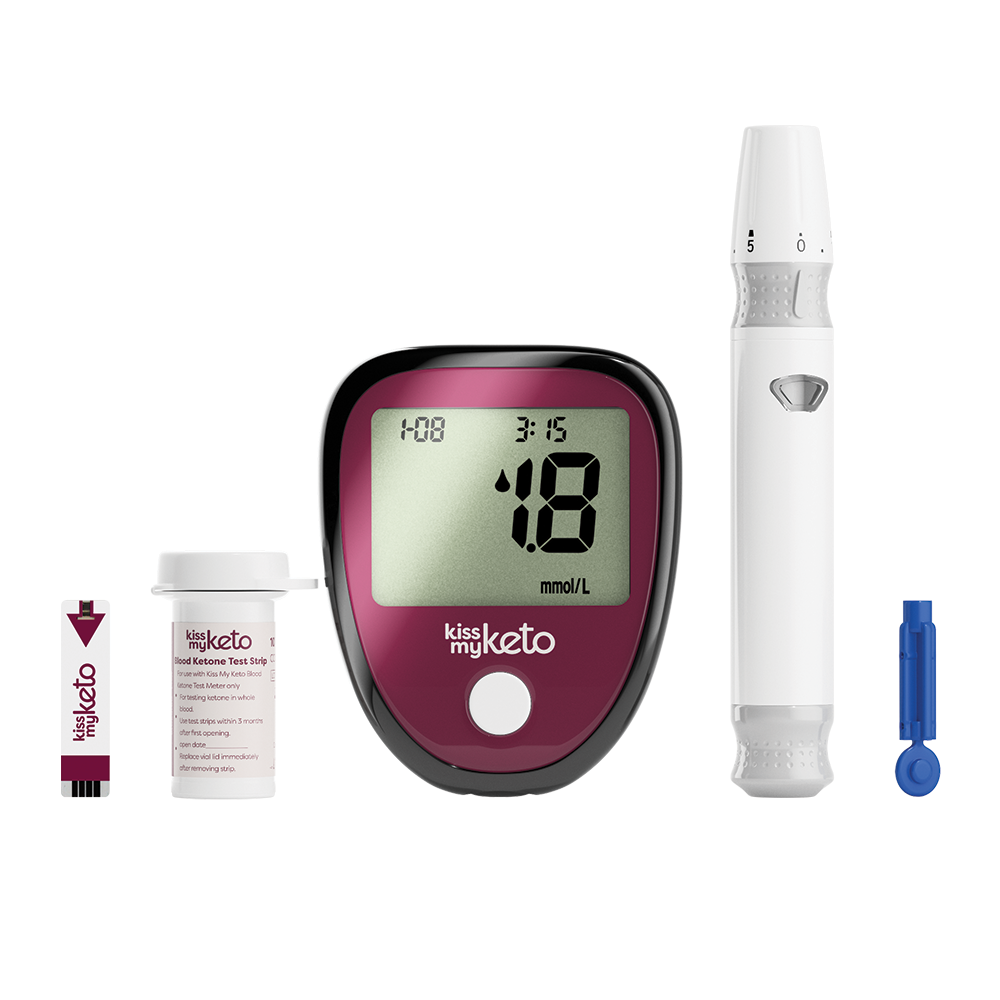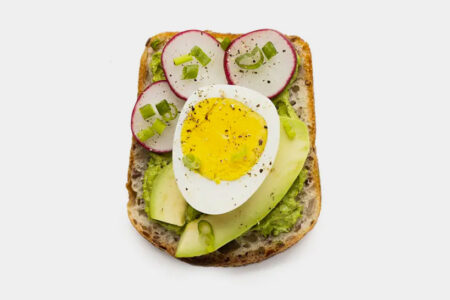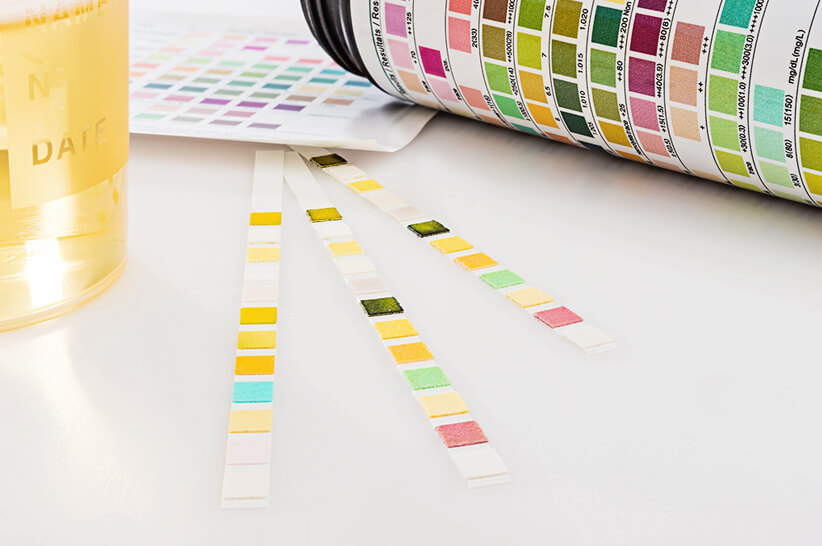Ketone strips, also called keto strips and ketone test strips, are thin paper strips that detect ketones in urine. They’re cheap, convenient, and will give you results within one minute, tops.
They do come with some drawbacks, however, which you definitely want to be aware of before making a purchase.
If you are curious as to why you need ketone strips in the first place, as well as how these products actually work and if there is any other way of testing for ketosis – then keep reading.
Our guide will also quickly go over the biochemistry of ketones and describe how your body uses and releases these compounds that so many keto dieters want more of.
What Are Ketones?
Ketones are water-soluble molecules that your liver makes in the absence of glucose. They include the following three:
- Acetoacetate
- Beta-hydroxybutyrate
- Acetone
The purpose of ketones is to provide the body with an alternative fuel source. On a standard high-carb diet, your body runs primarily on glucose (sugar). But when your body is starved of carbohydrates – like when you are on a ketogenic diet – it runs on fat and turns a portion of it into ketones.
Most cells in your body can use fat for energy, but your brain cannot. The brain needs ketones in order to survive when glucose is running low, and this is one reason why ketones exist. Another reason is because long-chain fatty acids cannot cross the blood-brain barrier 1.
When ketone levels start to rise, a simple test can detect them in the blood, breath, and urine. Ketone strips detect ketones in the urine. These test strips are the most popular and convenient way to test for ketosis, especially for keto dieters.
What Are Ketone Strips?
When on a ketogenic diet, your goal is to achieve ketosis – an altered metabolic state where the body burns fat instead of glucose for fuel. While in ketosis, your body also makes an abundance of ketones. “But how can I tell that I’m in ketosis?” you might ask. That’s where ketone strips come in handy.
When talking about ketone strips, what most people are referring to are paper test strips that test for ketones in urine. These products are available over the counter, in drugstores, and online. At Kiss My Keto, we also sell Ketone Urine Test Strips – 200 Count and at an affordable price at that.
Ketone strips were originally developed for people with type I diabetes who tend to be at a higher risk of ketoacidosis – a life-threatening condition where ketones reach dangerously high levels and make the blood acidic. In healthy people, however, the danger of ketoacidosis is extremely low, so there’s no need to for you to worry if you’re not diabetic.
If you are diabetic, however, keto test strips can be an easy way for you to monitor your health. Still, blood testing would be a more accurate way to do this. When doctors measure blood ketones, here is how they interpret the results 2:
- Below 0.5 mmol/L – normal
- Between 0.5-3 mmol/L – nutritional ketosis
- Over 3 mmol/L – high ketone levels
- Over 5 mmol/L – dangerously high and indicative of ketoacidosis
Keep in mind that the values used on ketone strips are different from the ones above. Most of the time, you’ll be looking for changes in color on the strip and comparing the results to a color chart that comes with the kit. Light pink means the level of ketones in your urine is low, while dark purple means the opposite (you’ll understand what we’re talking about in the next section).
How Do They Work?
Ketone urine-testing strips have an absorptive pad on one end. The pad contains a chemical reagent (usually nitroprusside) that changes color in the presence of acids such as ketones in urine 3. The color depth change varies depending on the concentration of ketones. Light pink means ketones are present but in small amounts. Dark purple means you’re in full-blown ketosis.

Most of the time, these tests detect acetone, and occasionally acetoacetic. The presence of both is a sure sign you are in ketosis. Beta-hydroxybutyrate, which is the most biologically active of the ketones, is largely present in blood and, unfortunately, kertone strips won’t detect it.
The way you use keto test strips is like this: you pee directly on the strip (on the part with the absorptive pad) or you immerse it in a urine sample. Then, you wait 15 seconds to a minute for the pad to change color. Compare the color to the color on the chart you received with the test kit, and voila, you know how many ketones are in your urine.
Are Ketone Strips Accurate?
Ketone strips are accurate when you’re just entering ketosis, that is in the first week or two of a ketogenic diet. This is the time when your body is still adapting to this diet. And in case you didn’t know, there is a difference between being in ketosis and being keto-adapted.
Ketosis is a metabolic state characterized by raised levels of ketone bodies; keto-adaptation is when your body is able to use these ketones for energy. More specifically, keto-adaptation is when your ketones start fueling your brain and fatty acids begin fueling your muscles.
After keto-adaptation, ketone strips may not be the most accurate way to measure ketone levels. The reason? Well, when your body makes more ketones than it can use, it gets rid of it through urine or breath. But when ketones are fully metabolized, few, if any, will appear in the urine.
What all this means is that ketone strips don’t always paint the full picture in terms of how many ketones are exactly in your system. On the bright side, ketone strips are cheap and you can use them when just starting a keto diet to see if your ketone levels are rising.
Some Alternatives
There are two more ways to test for ketones: with blood ketone meters and ketone breathalyzers. Both are more expensive than ketone urine test strips but also more accurate.
Blood ketone meters are the most expensive of the bunch. Not only does the actual meter cost $50-$100, but the test strips that go with it are also expensive.You do get the bang for your buck, however, as these tests detect beta-hydroxybutyrate – the most metabolically active of ketones.

Ketone breathalyzers, on the other hand, are cheaper but less accurate than ketone meters. These devices detect only acetone in the breath, but this doesn’t make them any less accurate. Studies show that breath acetone directly correlates with blood beta-hydroxybutyrate 4.
Another way to detect acetone in your breath is by smelling it. Acetone is a byproduct of beta-hydroxybutyrate and a highly volatile compound. When released through breath, it gives off a smell of nail polish that some also describe as “fruity”. If you’re noticing an unpleasant fruity breath lately – could be a sign of ketosis.
Do I Need to Test for Ketones?
In short, not really. Eating fewer than 50 grams of carbs per day is bound to put you into ketosis within a week or two. You can check for signs of ketosis like loss of appetite, weight loss, increased focus and energy, and a fruity breath.
But in case your curiosity is getting the best of you and you just need a sign that your body is making ketones, then try out ketone strips. You really have nothing to lose. Ketone strips are non-invasive, easy to use, cheap, and relatively accurate.
Make sure to test for ketones early in the morning or several hours after a meal. This will provide the most accurate results. Also, keep in mind that your hydration levels could affect your results. Researchers found that people with kidney problems may not get accurate results, so keep this handy fact in mind as well 5.
Conclusion
Ketone strips are an easy and affordable way to test for ketones in urine. They’re most accurate when used early in your keto diet. But you can use them at any time to see how things are going with your progress.
Ketone strips are most accurate in people without kidney problems and when used in the morning or after a meal. But don’t feel discouraged if no ketones get detected 2-3 weeks into your diet. This could simply mean that your body is using up all the ketones efficiently so none go to waste through urine.










![Juicing for Weight Loss: Everything You Need to Know [Plus Recipes]](/wp-content/uploads/2019/08/Juicing-for-Weight-featured-image.jpg)









Thanks very much for this explanation. I appreciate it!
You’re welcome, Laurie. ?
I’m a bit worried about my strips I’ve been in doing ketosis for 13 days (weight in tomorrow) but I’m done 13 and 1/2 pounds.
My strips and always dark like the max colour on the chart , I feel totally fine , have the thirst etc but drink about 2200ml + of water a day and stay about 75% fat – 20% protein and 5% carbs also use MCT oil.
On my colour chart it says the dark color is 16 mmol/L
So started googling and I now have the fear of something called diabetic ketoacidosis
Not sure if I should get a blood tester or go to a doctor asap any thoughts?
Hi Ryan. That sounds alarming. If I were you, I’d definitely schedule an appointment with my doctor. While urine strips have been known to give false-positive results for a wide range of reasons, it’s better to play it safe when you’re having these types of concerns.
I have been on the diet for 3 days now and my strip colour is 4.0. should i be concerned?
my strip keeps being in trace is that good or bad
So I’ve been doing keto for about 4 weeks now I just bought the urine strips I’m confused on what color I should be at some say the darker the better some say .3-5.0 I’ve dropped about 12-14 pounds already but I think that’s from none of the stuff I usually eat. I just need to know where I need to be on the urine strip to start burning fat? Please help
This was so informative. Thank you so much. Before reading this, I was trying to rethink my meals but I’ve been doing 20 carbs a day for the past month and a half. I will continue to do what im doing.
Great information without the confusion of complicated medical jargon. Very simplified and accurate. Made me feel empowered in my start of a Keto lifestyle.
This is such great information. I am new to Keto, just about 3 weeks and I want to make sure I’m doing it correctly and getting results. I appreciate the detail on measuring Ketones.